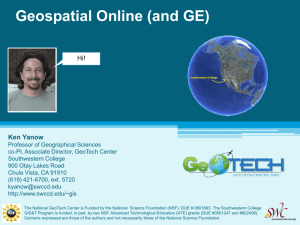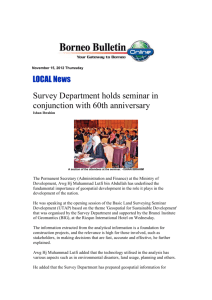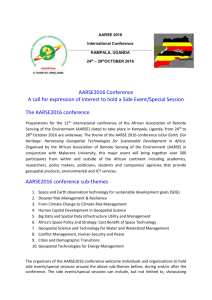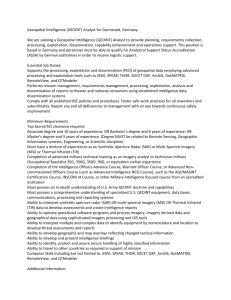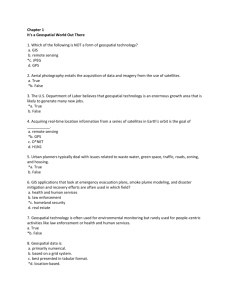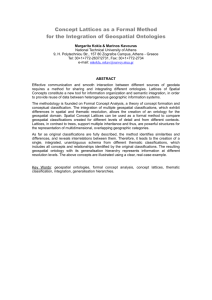Slide 1 - testing
advertisement
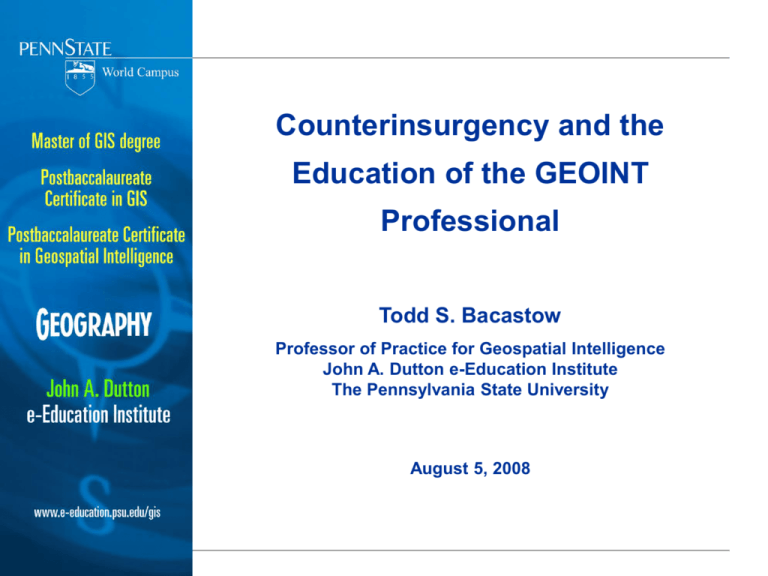
Counterinsurgency and the Education of the GEOINT Professional Todd S. Bacastow Professor of Practice for Geospatial Intelligence John A. Dutton e-Education Institute The Pennsylvania State University August 5, 2008 “Counterinsurgency is military, paramilitary, political, economic, psychological, and civic actions taken by a government to defeat insurgency.” Joint Pub 1-02/ FM 3-24 /MCWP 3-33.5, p. 1-1 U.S. Army Spc. Roger Rich visits with an Iraqi child during a stop in a village near the city of Musayyib, Iraq, while on a civil affairs mission, June 12, 2005. Rich is assigned to Scout Platoon, Headquarters and Headquarters Company, part of the 155th Brigade Combat Team. U.S. Navy photo by Chief Petty Officer Edward G. Martens. “Irregular Warfare (IR), Military Operations Other Than War (MOOTW), Limited Wars, or whatever other moniker the army has put on counterinsurgency (COIN), peacekeeping, peace-enforcement, etc., have traditionally received short shrift from the military education system….” Insurgency/Counterinsurgency: Does the Army “Get It?”, Kevin Reynolds, Feb 2007 COIN 101 - Principles It’s about competing for the loyalty of the people Firepower is not the answer The goal is to provide a secure environment for reforms and development Cut the insurgent off from support of the people If the insurgents obtain sanctuary from nearby nations the challenge is greatly increased Iraq, Jan. 30, 2005: An Iraqi man shows off his ink-stained finger after casting his ballot at a polling station in Jisr Diala on the southern outskirts of Baghdad, Iraq. (AP Wide World Photo/John Moore). COIN 101 - Phases Source: RAND, 2008 COIN 101 – Intelligence Conventional conflict • Identifies opportunities and constraints • Collects on the enemy’s “industrial footprint” • Goal is to help destroy the enemy force • Situational templates with data pushed to the analyst • Standards for communicating COIN • Identifies who and why • Collects on the population • Goal is to correlate, track, and apprehend • Highly varied needs with locally developed data • Ad hoc information exchange with many • Is law enforcement-like Source: RAND, 2008 What’s education? • Education is concerned with the development of the intellect • Training deals with learning specific skills • Education is a personal activity • Training is developing skills for others “the exploitation and analysis of imagery and geospatial information to describe, assess, and visually depict physical features and geographically referenced activities on the Earth.” Title 10 U.S. Code §467 “a means of visualising the instance, situation or forecasting the same.” Brigadier Nick Rigby former Director of Intelligence for the UK Ministry of Defense Geospatial Intelligence GEOINT What’s geospatial intelligence? Geospatial intelligence Cholera outbreak in Soho, England, in 1854 Dr. John Snow (1813-1858), a legendary figure in understanding and resolving a social problem through the use of spatial analysis. Geospatial intelligence professional No adequate definition since the field is too new • 2001 - Developing the Geospatial Workforce • 2003 - Geographic Information Science and Technology Body of Knowledge (GISTBoK) • 2007 - US Geospatial Intelligence Foundation Accreditation Standards Broad competency areas Technical Situational Analytical Personal After: Building the Geospatial Workforce Cyndi H. Gaudet, Heather M. Annulis, and Jon C. Carr URISA Journal • Vol. 15, No. 1 • 2003 PSU Geospatial Intelligence Program GEOG 882 Geographic Foundations of Geospatial Intelligence GEOG 883 Remote Sensing for the Geospatial Intelligence Professional GEOG 884 Geographic Information Systems for the Geospatial Intelligence Professional IST 885 Introduction to Multi-Sensor Data Fusion GEOG 889 Virtual Field Exercise for the Geospatial Intelligence Professional PSU vs ABCA Report Many of Penn State’s educational objectives miss the needs of geospatial intelligence professional the COIN domain. # 10 - Legal Current Needed • Awareness • Evaluating the host country legal issues associated with data collection and human rights # 9 - Geospatial Forensics Current Needed • Collect data for manipulation • Protocols to collect, process, safeguard, and evaluate spatial data as evidence # 8 - Language/Communications Current Needed • National/ international cartographic standards • Preparing the professional for effective cross cultural/ organizational communications of geospatial information Soviet era map symbols http://www.armchairgeneral.com/rkkaww2/maps/keymap/chapter2_1.pdf # 7 – Organizational Current Needed • Understanding the US intelligence community • Working as a team of nations, global NGOs, and foreign agencies • Customer relationship management map of NATO PRTs in Afghanistan, valid as at 20 April 2007. [23] A full-size version of this map is available at: http://www.nato.int/ISAF/media/pdf/placemat_isaf.pdf # 6 – Working with open source Current Needed • Approached in an ad hoc manner • Preparation to find, evaluate, and use unstructured text, hard and softcopy maps, atlases, gazetteers, human terrain data (cultural and economic),etc # 5 – Working with data Current Needed • Data about the open-physical environment • Applying known data sources • Understanding data issues • Applying existing formats • Data about the human and urban environment • Creating SDI-like data organizations • Analyzing data quality • Creating data structures Iraqi survey data collectors speak with a village elder during the course of the first phase of the Landmine Impact Survey. http: www.state.gov/r/pa/ei/pix/b/91052.htm # 4 – Add to the toolset Current Needed • • • • • • • • • Overlay Buffering Containment Image processing Cluster analysis Network analysis Diffusion modeling Trend analysis Predictive modeling/gaming A Social Network Analysis of the Iranian Government, [November, 2001] # 3 – Ethics education Current Needed • Awareness • Evaluating an ethical issues with respect to data collection and analytical practice # 2 – Culture Current Needed • Awareness • Evaluating the impact of culture on data collection and analytic results Fairfax County Police, www.fairfaxcounty.gov/police/police31.htm # 1 – Geospatial analytic thinking Current Needed • Workflows • Structured methods to help overcome human cognitive limitations or pitfalls We recommend the following GIS workflow: 1. Define the problem or scenario. 2. Identify the deliverables (mostly maps) needed to support the decision. 3. Identify, collect, organize, and examine the data needed to address the problem. 4. Document your work: a. Create a process summary. b. Document your map. c. Set the environments. 5. Prepare your data. 6. Create a basemap. 7. Perform your analysis. 8. Produce the deliverables, draw conclusions, and present your results. Our World GIS Education Level 4: Making Spatial Decisions, ESRI Geospatial analytic thinking • The geospatial professional should: – Understand the cognitive biases and fallacies – Apply appropriate geospatial techniques for creating and testing hypothesis • rational choice theory • utility theory • game theory, etc. – Evaluate temporal-spatial trend analysis and spatial correlation – Apply forecasting methods in the geospatial domain • • • • • decision tree analysis analytic hierarchy process alternative scenarios/futures Delphi technique Lockwood Analytical Method for Prediction (LAMP) Summary Physical Human Open terrain Closed terrain Data Evidence Top down Bottom up Individual Team Descriptive Predictive Workflows Analytic process “We must cease confusing mastery of software commands with attaining a grasp of critical intellectual concepts.” Duane F. Marble, ArcNews, 1998 U.S. Army Maj. Robert Holbert takes notes as he talks and drinks tea with local school and Andar Special Needs School administrators during a cordon and search of Nani, Afghanistan, on June 2, 2007. Holbert is attached to the Human Terrain Team, 4th Brigade Combat Team. DoD photo by Staff Sgt. Michael L. Casteel, U.S. Army. (Released) Key References • Counterinsurgency Warfare, Galula, 1964 • The Changing Face of War: Into the Fourth Generation, Lind, 1989 • Field Manual 100-7, Decisive Force: The Army In Theater Operations, 1995 • Military Operations Other Than War Briefing Slides and Script, J7, undated • The Information Edge: Imagery Intelligence and geospatial Information in an Evolving National Security Environment, NIMA, 2000 • Developing the Geospatial Workforce, Gaudet, 2001 • GIS & T Body of Knowledge, DiBiase, 2003 • Learning to Eat Soup with a Knife, Nagl, 2005 • Army-Marine Corps Counter Insurgency Field Manual, January 2007 • ABBA Report, 2007 • USGIF Accreditation Standards, 2007 • A Conceptual Framework for Facilitating Geospatial Thinking, Golledge, 2008 • Analytic Support to Intelligence in Counterinsurgency, RAND, 2008 • International Association for Intelligence Education Conference, June 2008 • The Future of Intelligence Co-operation between Military Forces and Private Security Companies based on Lessons Learned in Iraq" Strachan-Morris, Mar 2008 • Taxonomy of Structured Analytic Techniques, Presentation, IAFIE Conference, June 2008 • Insurgency/Counter-Insurgency: Does the U.S. Army "Get It," Reynolds, June 2008
